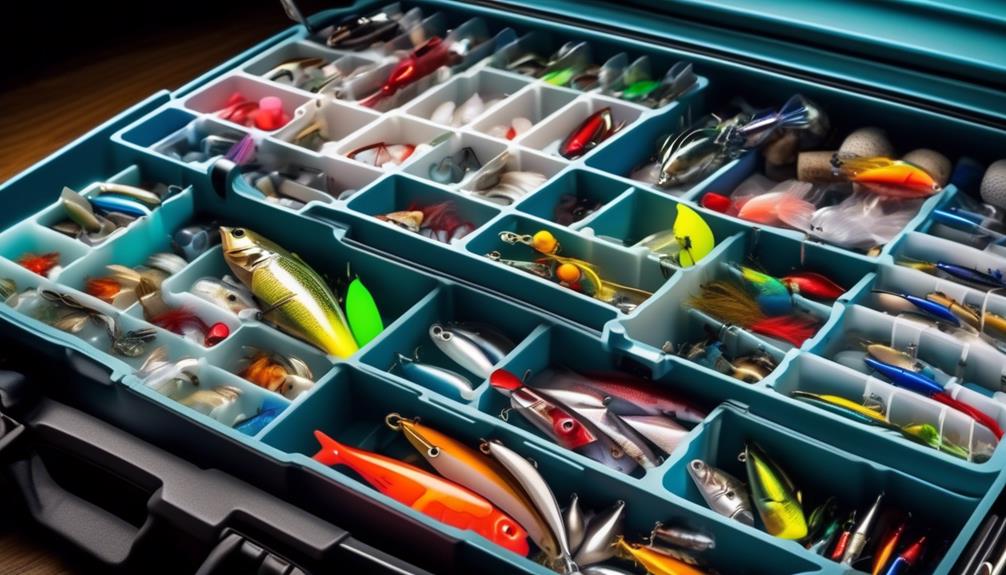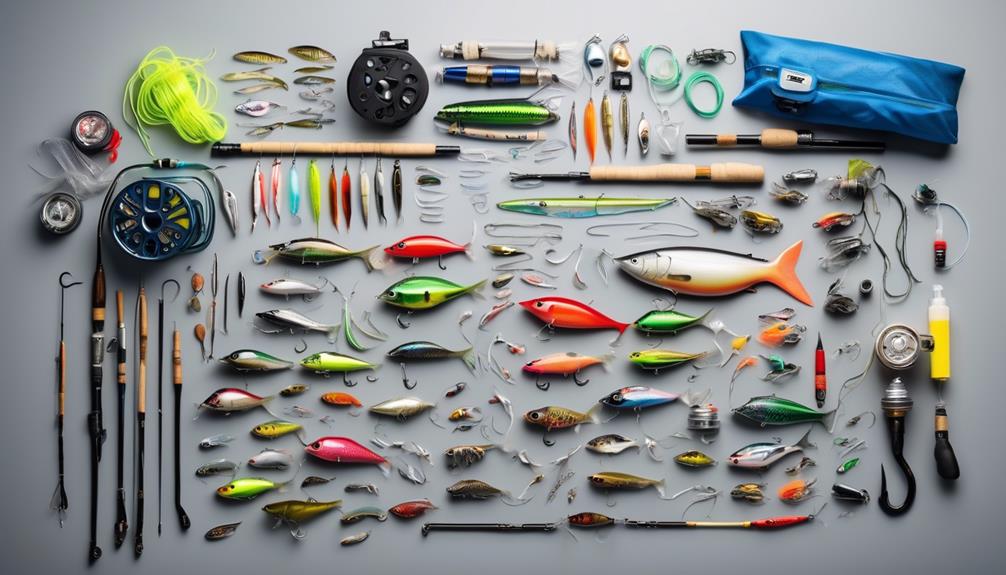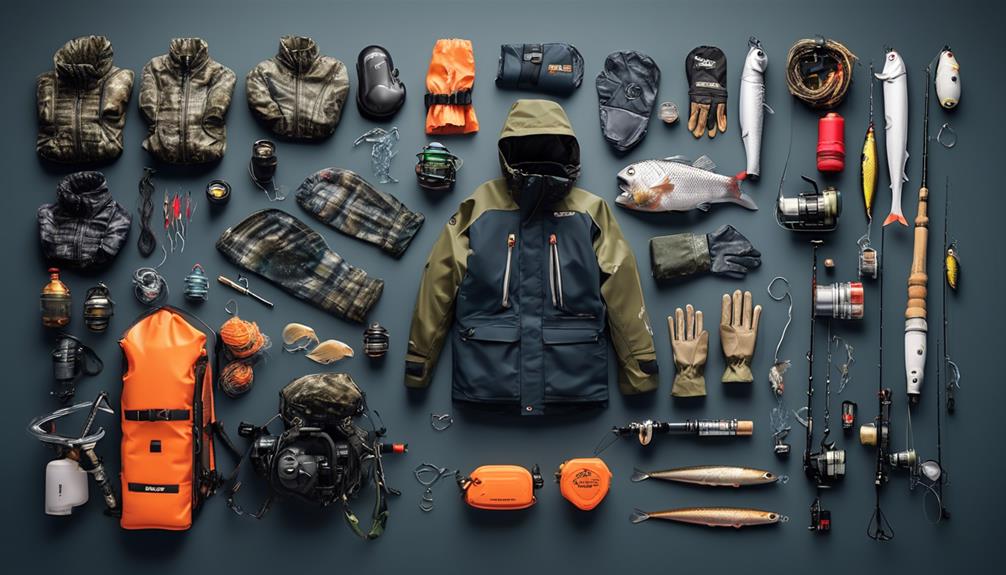You're gearing up for your next saltwater fishing adventure, and as you're browsing through the overwhelming array of tackle and gear options, you're probably wondering how to find quality equipment without breaking the bank. Well, look no further.
In this guide, we'll explore a range of affordable saltwater fishing tackle and gear that will help you reel in the big catch without emptying your wallet. Whether you're a seasoned angler or just getting started, this guide will provide you with valuable insights and practical tips to make the most of your saltwater fishing experience.
Rods and Reels
When selecting saltwater fishing tackle, it's essential to choose rods and reels that can withstand the harsh conditions of the ocean environment. For rod maintenance, opt for rods made of corrosion-resistant materials such as graphite or fiberglass. These materials can handle the saltwater exposure without deteriorating quickly. After each fishing trip, rinse your rod with freshwater and wipe it down to remove any salt residue. Additionally, check for any signs of wear and tear, such as corrosion on the guides or reel seat, and address them promptly to prolong the life of your rod.
When it comes to reel selection, prioritize corrosion resistance and durability. Look for reels with sealed bearings and components to prevent saltwater from causing damage. Saltwater can be particularly harsh on reels, so investing in a high-quality, saltwater-specific reel is crucial. After each use, rinse your reel with freshwater and gently dry it to prevent salt buildup. Regularly lubricate the moving parts and check for any signs of corrosion. Proper maintenance will ensure that your reel continues to perform smoothly and reliably.
Lines and Leaders
For reliable performance in saltwater fishing, it's essential to select high-quality lines and leaders that can withstand the challenges of the ocean environment. When it comes to lines and leaders, proper knot tying is crucial. Make sure to learn and master strong and reliable knots like the improved clinch knot, palomar knot, and the double uni knot. These knots will ensure that your line stays secure when battling strong, aggressive saltwater fish.
In saltwater fishing, line maintenance is key to ensuring your gear lasts and performs well. After every fishing trip, inspect your line for any signs of wear and tear, such as nicks or frays. Saltwater can be particularly harsh on fishing lines, so it's important to rinse your line with fresh water after each use to remove any salt and debris. This simple step can significantly extend the life of your line and maintain its strength.
When selecting a leader, opt for fluorocarbon or monofilament leaders that are abrasion-resistant and can handle the sharp teeth and rough mouths of saltwater species. It's also important to check your leader for any damage after each catch and retie if necessary.
Hooks and Rigs
To ensure successful catches in saltwater fishing, carefully selecting the right hooks and rigs is essential. When it comes to bait presentation, the type of hook you choose can make a significant difference. For live bait, using circle hooks is effective as they're designed to hook the fish in the corner of the mouth, reducing the risk of deep hooking and potential harm to the fish. For artificial lures, consider using treble hooks for better hooking efficiency. Additionally, ensuring your bait is presented naturally and enticingly is crucial. This can be achieved by using rigs such as Carolina rigs, which allow the bait to move freely, or by incorporating techniques like adding a teaser above the main hook to simulate a school of baitfish.
Proper knot tying is imperative to ensure that your hooks and rigs are securely attached to your line. The improved clinch knot is a popular and reliable choice for tying hooks to the line. It provides strength and security, essential for landing big catches. When it comes to rigging, the loop knot is often preferred as it allows for natural movement of the bait or lure, enhancing its presentation to the fish. Taking the time to perfect your knot tying skills will ultimately lead to more successful and satisfying fishing experiences.
Lures and Baits
Selecting the right lures and baits is crucial for successful saltwater fishing, as they play a pivotal role in attracting and enticing your target species. When it comes to saltwater fishing, the right lures and baits can make all the difference in your catch. Here are some tips to help you choose the best lures and baits for your next saltwater fishing adventure:
- Types of lures: Different types of lures work best for different saltwater species. For example, topwater lures are great for surface-feeding fish like striped bass and bluefish, while soft plastic swimbaits are ideal for enticing predatory species such as snook and redfish. Understanding the behavior and feeding habits of your target species will help you select the most effective lures for your saltwater fishing trip.
- Popular bait choices: Live bait can be incredibly effective in saltwater fishing. Species like shrimp, mullet, and pilchards are popular choices for live bait, as they closely mimic the natural prey of many saltwater fish. Additionally, artificial baits such as soft plastic shrimp and crab imitations can also be highly effective, especially when targeting bottom-dwelling species like flounder and black sea bass.
- Matching the hatch: Observing the local baitfish and forage species can provide valuable insights into the best lures and baits to use. By choosing lures and baits that closely resemble the prevalent baitfish in the area, you can significantly increase your chances of attracting bites from saltwater predators.
Fishing Tools and Accessories
You need a reliable set of fishing tools and accessories to ensure a smooth and successful saltwater fishing experience. When it comes to saltwater fishing, mastering fishing knot tying techniques is essential. Practice tying strong and reliable knots, such as the improved clinch knot, palomar knot, and loop knot, to ensure your lines can withstand the strength of saltwater fish. Regularly check and maintain your fishing reels, rods, and lines to prevent corrosion from the saltwater. Rinse them with fresh water after each use and lubricate the moving parts to keep them in top condition.
In addition to mastering knot tying and maintenance, there are several essential fishing accessories and useful gadgets that can enhance your saltwater fishing experience. A good pair of polarized sunglasses can help reduce glare on the water's surface, allowing you to spot fish more easily. A quality pair of fishing pliers is vital for safely removing hooks and cutting lines. Consider investing in a portable fish finder to locate underwater hotspots where fish are likely to gather. A waterproof tackle box will keep your lures and baits organized and protected from the elements.
Protective Gear and Apparel
When preparing for saltwater fishing, outfit yourself with the necessary protective gear and apparel to ensure both comfort and safety during your angling adventures.
Here are some essential items to consider:
- Sun Protection and Rain Gear: The harsh sun and unpredictable weather can quickly turn a pleasant fishing trip into an uncomfortable experience. Invest in a wide-brimmed hat, polarized sunglasses, and lightweight, moisture-wicking clothing with UPF protection to shield yourself from harmful UV rays. Additionally, pack a waterproof jacket or poncho to stay dry during sudden downpours, ensuring you're prepared for whatever nature throws your way.
- Fishing Gloves and Footwear: Protect your hands from cuts, abrasions, and harsh weather conditions with a reliable pair of fishing gloves. Look for options with reinforced palms and finger protection for handling fish and equipment. When it comes to footwear, prioritize comfort, support, and slip-resistance. Choose water-resistant, quick-drying shoes or boots with good traction to navigate wet decks and rocky shores with confidence.
- Appropriate Layering: Dressing in layers allows you to adapt to changing temperatures throughout the day. Start with a moisture-wicking base layer to keep sweat away from your skin, add an insulating mid-layer, and top it off with a waterproof and wind-resistant outer layer. This versatile approach ensures you stay comfortable and dry, regardless of the weather conditions you encounter.
Equipping yourself with the right protective gear and apparel not only enhances your fishing experience but also ensures you can focus on reeling in the big catch without worrying about discomfort or safety hazards.
Tackle Storage Solutions

Outfit yourself with effective tackle storage solutions to seamlessly organize your gear and ensure easy access while out on the water. Tackle organization is essential for a successful fishing trip, and having the right storage options can make a significant difference.
When it comes to tackle organization, there are various storage options to consider. Tackle boxes are a popular choice, offering compartments and trays to keep different types of tackle neatly organized. Look for tackle boxes with adjustable dividers, allowing you to customize the storage space to fit your specific gear.
Soft tackle bags are another excellent option, providing flexibility and portability. These bags often feature multiple pockets and sleeves, offering ample room for organizing various tackle items. Additionally, consider investing in tackle binders or wallets for smaller items like hooks, sinkers, and artificial bait. These compact storage solutions are convenient and can be easily transported.
For bulkier gear such as lures, consider utilizing tackle trays or boxes with adjustable slots to keep everything in place. Another space-saving solution is utilizing storage racks or shelves in your boat or kayak to keep larger tackle items organized and easily accessible.
It's important to assess your specific gear and fishing needs to determine the most suitable tackle storage solutions for your outings. By investing in the right tackle organization and storage options, you can spend less time searching for gear and more time enjoying your saltwater fishing adventures.
Budget-Friendly Tackle Kits
Considering a tight budget, finding budget-friendly tackle kits can be a practical solution for anglers looking to maximize value without compromising on quality. These kits are designed to provide essential fishing gear at an affordable price, making them an attractive option for beginners and seasoned anglers alike.
Here are three reasons why investing in budget-friendly tackle kits is a smart choice:
- Value for Money: Budget-friendly tackle kits offer a cost-effective way to acquire a variety of fishing gear without breaking the bank. By purchasing a kit, you can save money compared to buying each item individually. This allows you to stretch your budget further, enabling you to invest in other aspects of your fishing experience.
- Convenience and Accessibility: These kits provide the convenience of having all the necessary tackle in one package, eliminating the need to spend time researching and purchasing individual items. This accessibility ensures that you have the essential gear needed for your fishing trips, saving you the hassle of hunting down each piece separately.
- Tackle Maintenance and DIY Repairs: Many budget-friendly tackle kits come with basic tools and materials that can assist in tackle maintenance and DIY repairs. This not only saves you money in the long run by extending the lifespan of your gear but also empowers you to handle minor repairs on your own, fostering a deeper connection with your equipment.
Investing in a budget-friendly tackle kit can provide you with the essential gear needed for saltwater fishing while being mindful of your budget.
Frequently Asked Questions
What Are the Best Saltwater Fishing Spots for Beginners?
If you're new to saltwater fishing, start at spots like piers or jetties. Look for areas with clear water and structure. Bring the best equipment and try fishing techniques like bottom fishing or using live bait.
How Can I Properly Maintain and Clean My Saltwater Fishing Gear?
To properly maintain and clean your saltwater fishing gear, rinse it with freshwater after each use to remove salt and debris. Use a mild soap and water to clean, then thoroughly dry to prevent corrosion.
What Are Some Common Mistakes to Avoid When Saltwater Fishing?
When saltwater fishing, avoid overfishing by following local regulations and guidelines. Properly handle and release any unwanted or undersized catches. Mistakes to avoid include improper handling of fish, damaging the environment, and disregarding size limits.
Are There Any Special Regulations or Permits Required for Saltwater Fishing in Certain Areas?
In some areas, special regulations and permits are required for saltwater fishing. It's important to research and follow conservation practices, and learn about catch and release techniques to protect the marine environment.
What Are Some Safety Tips for Fishing in Saltwater Environments?
When fishing in saltwater, always take safety precautions. Check the weather, wear appropriate gear, and know how to swim. Bring necessary equipment like life jackets and a first aid kit. Stay alert and prepared.
Conclusion
Now that you have all the affordable saltwater fishing tackle and gear you need, it's time to hit the water and start reeling in those big catches.
With the right equipment and a little bit of skill, you'll be landing fish in no time.
So grab your gear, head out to your favorite fishing spot, and enjoy the thrill of saltwater fishing without breaking the bank.
Happy fishing!



